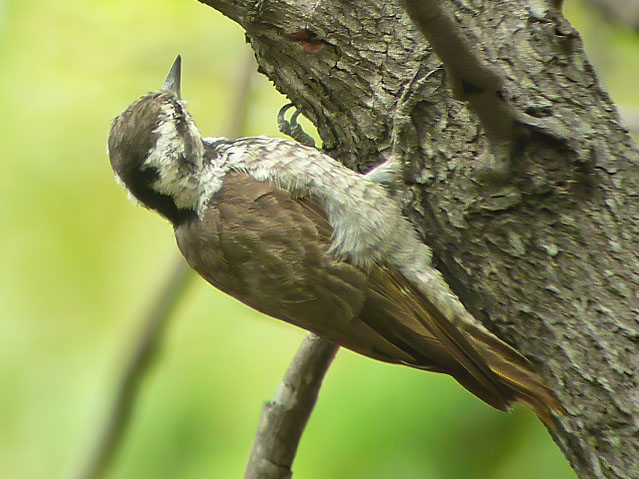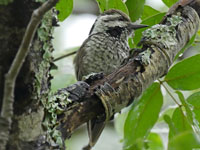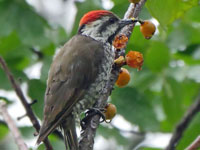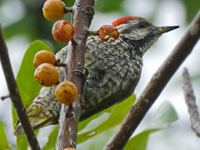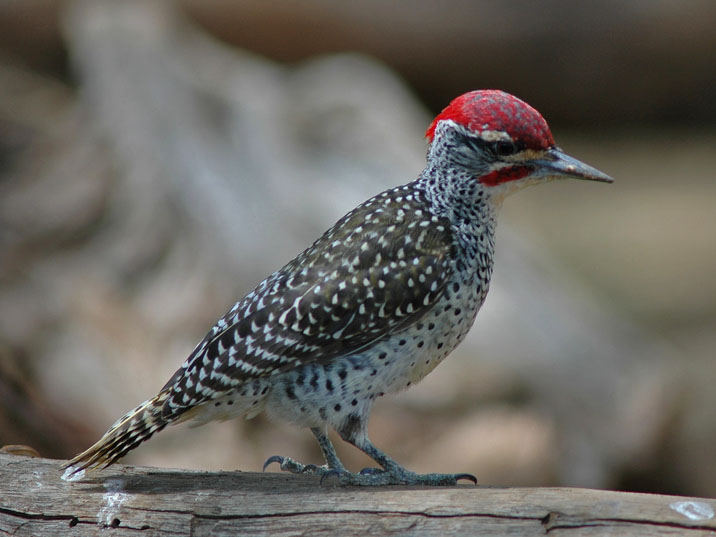The order Piciformes is made up of the woodpecker family Picidae plus 8 other families. Picidae make up about half of the species. In general, the Piciformes are insectivorous, but some exceptions eat mostly fruit. Nearly all Piciformes have parrot-like feet—two toes forward and two back, an arrangement that has obvious advantages for birds that spend much of their time on tree trunks. And most Piciformes do not have down feathers at any age, only true feathers. All nest in cavites.
Family Picidae: Woodpeckers and Allies
The woodpeckers family members are found almost worldwide. Most species live in forests or woodland habitats, although a few species are known to live in treeless areas such as rocky hillsides and deserts. They range in size from 8-50 cm. Many species exhibit patches of red and yellow on their heads and bellies, and these bright areas are important in signalling. Although the sexes of Picidae species tend to look alike, many have more prominent red or yellow head markings in males than in females.
Members of the family Picidae have strong bills for drilling and drumming on trees and long sticky tongues for extracting food. Species that use their bills in soil or for probing as opposed to regular hammering tend to have longer and more decurved bills. To prevent brain damage from the rapid and repeated decelerations, woodpeckers have evolved a number of adaptations to protect the brain. These include small brain size and the short duration of contact. The millisecond before contact with wood a thickened membrane closes, protecting the eye from flying debris. The nostrils are also protected, they are often slit-like and have special feathers to cover them. In addition to the strong claws and feet woodpeckers have short strong legs, this is typical of birds that regularly forage on trunks. The tails of most woodpeckers are stiffened, and when the bird perches on vertical surfaces, the tail and feet work together to support it. Picidae species can either be sedentary or migratory.
There are 7 articles pertaining to the woodpecker family Picidae: African, Eurasian, North America, South America, Small, Large, Terrestrial.
This article describes the 80% of the African woodpeckers that are in genera Campethera and Chloropicus. The remaining 7 African woodpeckers are scattered in 6 different genera which contain mostly non-African species. The Campethera and Chloropicus species are typical small to medium sized woodpeckers that eat mainly insects and forage mainly in trees.
The other African species are in the following genera: Dendrocopos (great spotted woodpecker), Dryobates (lesser spotted woodpecker), Geocolaptes (ground woodpecker), Jynx (Eurasian wryneck, rufous-necked wryneck), Picus (Levaillant's woodpecker), and Verreauxia (African piculet).
Genus Campethera Found : Africa
They are small to medium size woodpeckers varying in length from 15 to 25 cm. The males and females of these species are very similar, with difference mainly restricted to the crown, nape, and also sometimes a malar stripe. In all case, the male has more red plumage than the female. All excavate nest hole in trees. The entire nest tree may be dead, or merely the section where the cavity is located. They mainly eat insects, especially ant, termites, and insect larvae. Most foraging is done in trees, either by hammering with their bill or gleaning from surfaces. Some species also feed on the ground and the Bennett's woodpecker (Campethera bennettii) feeds mainly on the ground. Of the 11 species in this genus, all but one are listed as Least Concern. The Knysna woodpecker (Campethera notata) is listed as Near Threatened,
Woodpecker,_Bennett's Campethera bennettii
Description: The Bennett's woodpecker has brown upperparts with white barring. There is a yellow tinge towards the rear. It has a white chin and throat. The underparts are pale yellow with dark spots. It has red eyes, a grey bill, and green legs. The male has a red crown and malar stripe while the female has a black fore-crown with white spots, a red rear-crown, black cheek patch, and a white malar stripe. It is 25 cm long and weighs 60 to 85 grams.
Range: Southern Africa.
Habitat: Woodlands and bushes.
Diet: Mainly ants, termites, and their larvae. It feeds mainly on the ground.
Conservation status: Least Concern.
Image by: 1) Lip Kee - Botswana 2) Bernard_Dupont - South Africa 3) Derek Keats - South Africa 4) Nik Borrow - ZambiaRange: Southern Africa.
Habitat: Woodlands and bushes.
Diet: Mainly ants, termites, and their larvae. It feeds mainly on the ground.
Conservation status: Least Concern.
1) Male on left, Female on right 2) Female 3, 4) Male
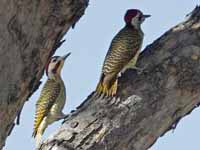

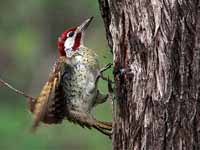
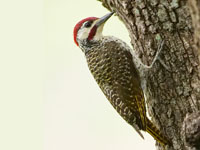
Woodpecker,_Brown-eared Campethera caroli
Description: The brown-eared woodpecker has olive-brown upperparts, a dark brown tail, a dark brown ear-covert, and an olive-green throat speckled with white. It has olive-green underparts streaked with buff, yellow or white. The male has a dark brown fore-crown and red hind-crown, while the female lacks the red. It is 18 cm long and weighs 50 to 70 grams. It has a nest cavity in a tree or dead stump.
Range: Central tropical Africa.
Habitat: Forests, secondary foresst with dangling vines and thick regrowth. Also grassy woodlands and plantations.
Diet: Ants, other insects, larvae. Forages low in the trees, but not usually on the ground,
Conservation status: Least Concern.
Image by: 1) Steve Garvie - Kenya 2) Ross_Tsai - Uganda 3) Steve_GarvieRange: Central tropical Africa.
Habitat: Forests, secondary foresst with dangling vines and thick regrowth. Also grassy woodlands and plantations.
Diet: Ants, other insects, larvae. Forages low in the trees, but not usually on the ground,
Conservation status: Least Concern.
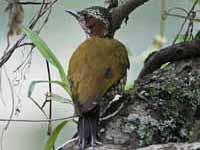

Woodpecker,_Buff-spotted Campethera nivosa
Description: The buff-spotted woodpecker has plain green upperparts and yellowish-olive or dark olive underparts spotted or barred with buff. The male has a dark olive or blackish crown and a bright red nape. The female has a dark nape. They are aobut 15 cm long and weigh 30 to 50 grams. It nests in a tree cavity or a termite nest that is in a tree.
Range: Central Africa.
Habitat: Woodlands, treed grasslands, mangroves, gardens.
Diet: Mainly ants and termites. Forages in trees. It particularly likes ant and termite nests that are in trees.
Conservation status: Least Concern.
Image by: 1) Ross_TsaiRange: Central Africa.
Habitat: Woodlands, treed grasslands, mangroves, gardens.
Diet: Mainly ants and termites. Forages in trees. It particularly likes ant and termite nests that are in trees.
Conservation status: Least Concern.
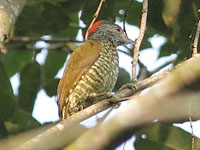
Woodpecker,_Fine-spotted Campethera punctuligera
Description: The fine-spotted woodpecker has green upperparts with fine pale spots. There are bars on the rump and tail, The underparts are whitish or yellowish with fine dark spots. The male has a red crown while the female has a dark fore-crown with red on rear half. The fine-spotted woodpecker is 22 cm long and weighs 55 to 75 grams. The nest is built in a tree hole, often in an oil palm.
Range: Central tropical Africa.
Habitat: Wooded savannah, scrub and grassland with scattered Acacia and other trees.
Diet: Ants, termites, and their larvae. Feeds in the trees and also on the ground.
Conservation status: Least Concern.
Image by: 1, 2) Allan Hopkins - Gambia 3) Francesco_Veronesi - GambiaRange: Central tropical Africa.
Habitat: Wooded savannah, scrub and grassland with scattered Acacia and other trees.
Diet: Ants, termites, and their larvae. Feeds in the trees and also on the ground.
Conservation status: Least Concern.
1) Female 2, 3) Male

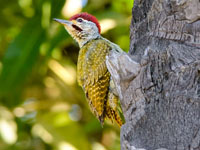
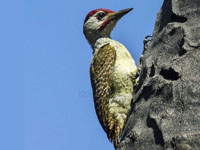
Woodpecker,_Golden-tailed Campethera abingoni
Description: The golden-tailed woodpecker has greenish-brown upperparts with pale barring. There is a golden tinge to its lower back and tail. It has grey orbital skin around a reddish eye, and a white supercilium above. The male has a red crown and nape. The female has a black crown with white spots; her nape is also red. The underparts are white with black streaking which transitions to spots on the lower-belly. The golden-tailed woodpecker is 20 to 21 cm long and weighs about 70 grams.
Range: Central and southern Africa.
Habitat: Woodlands, forest edges, savanna with brush or trees available.
Diet: Arboreal ants and termites, but also takes millipedes, wood-boring larvae and leaf-feeding moth larvae. Does not forage on the ground.
Conservation status: Least Concern.
Image by: 1) Nik_Borrow - Gambia 2) Arno Meintjes 3) Derek_Keats - South Africa Range: Central and southern Africa.
Habitat: Woodlands, forest edges, savanna with brush or trees available.
Diet: Arboreal ants and termites, but also takes millipedes, wood-boring larvae and leaf-feeding moth larvae. Does not forage on the ground.
Conservation status: Least Concern.
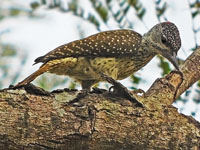
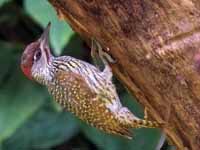
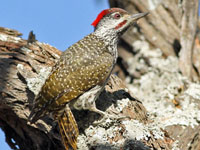
Woodpecker,_Green-backed Campethera cailliautii
Description: The green-backed woodpecker, also known as the little spotted woodpecker, has green upperparts spotted with buff or yellow, buff or white underparts with black spots, black barring on the white flanks. The male has a scarlet crown flecked with black plus a red nape. The female has a blackish fore-crown crown spotted with white and red rear-crown. The green-backed woodpecker is 16 cm long.
Range: Central Africa.
Habitat: Requires some trees, but other than that the habitat is varied.
Diet: Mainly ants and termites which if finds in trees.
Conservation status: Least Concern.
Image by: 1) Nik_Borrow - Uganda 2) Peter_Steward - Kenya 3) Francesco Veronesi Range: Central Africa.
Habitat: Requires some trees, but other than that the habitat is varied.
Diet: Mainly ants and termites which if finds in trees.
Conservation status: Least Concern.
1, 2) Female 3) Male

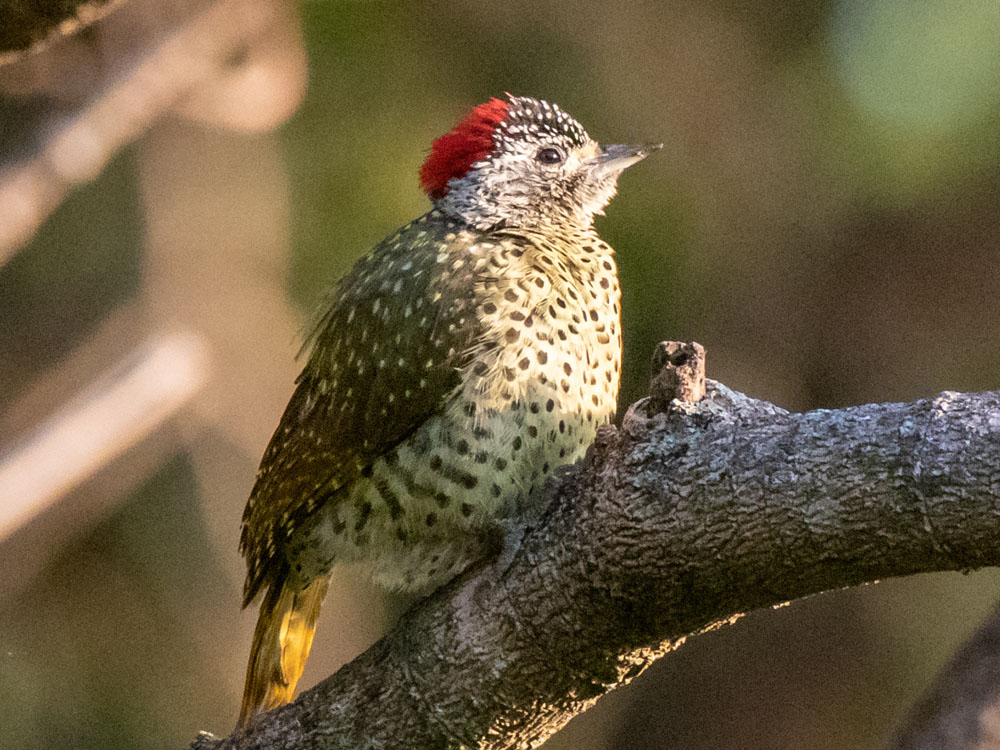
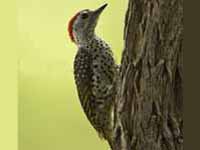
Woodpecker,_Knysna Campethera notata
Description: The Knysna woodpecker has olive green upperparts with faint spots and an olive-brown tail crossed with 6 bars of almost yellow color. There are grey-black feathers on the crown that are tipped with scarlet (female has scarlet only on the rear-crown). It has whitish ear coverts streaked with black, yellowish underparts covered with large black spots that distinguish it from other species. It is about 21 cm long and 60 grams. Both sexes excavate a nest cavity in a tree.
Range: Southern South Africa.
Habitat: Woodlands, forest edges, savanna with trees.
Diet: Mainly ants and ant larvae; also wood-boring beetles, and termites. It feeds exclusively in trees.
Conservation status: The Knysna woodpecker is listed as Near Threatened because of habit degradation.
Image by: 1) Ragnhild_and_Neil_Crawford.Range: Southern South Africa.
Habitat: Woodlands, forest edges, savanna with trees.
Diet: Mainly ants and ant larvae; also wood-boring beetles, and termites. It feeds exclusively in trees.
Conservation status: The Knysna woodpecker is listed as Near Threatened because of habit degradation.

Woodpecker,_Little_Green Campethera maculosa
Description: The little green woodpecker has yellowish-green or bronze-green upperparts, brown flight feathers with buffish bars, and a blackish tail with some yellow and green. The head, neck, and throat are buff with brown spots. It has a buffish breast and greenish-white belly. There are deep olive bars on all the underparts. The male has an olive-blackish crown with some indistinct red plus a red nape. The female has no red on her crown plus buff spots on crown and nape. It is about 16 cm long and 55 grams. The nest is an excavated hole in either the tree itself of an ant / termite nest in the tree.
Range: West central Africa.
Habitat: Primary and secondary forests, clearings, and mosaics of forest and shrub, at elevations up to 1,000 meters.
Diet: Arboreal ants and termites.
Conservation status: Least Concern.
Image by: 1) Nik_Borrow - LiberiaRange: West central Africa.
Habitat: Primary and secondary forests, clearings, and mosaics of forest and shrub, at elevations up to 1,000 meters.
Diet: Arboreal ants and termites.
Conservation status: Least Concern.

Woodpecker,_Mombasa Campethera mombassica
Description: The Mombasa woodpecker has green upperparts with small pale spots, The male has a green fore-crown, red rear-crown, red nape, and red malar stripe. The female has mostly black crown with white spots and some red at the back of the crown. Her malar stripe is black. The underparts and neck are pale with dark narrow streaks. It is about 22 cm long and 60 grams.
Range: Kenya, Somalia, Tanzania.
Habitat: Near the coast in woods.
Diet: Mainly ants which it finds in trees.
Conservation status: Least Concern.
Image by: 1, 2) Steve Garvie - KenyaRange: Kenya, Somalia, Tanzania.
Habitat: Near the coast in woods.
Diet: Mainly ants which it finds in trees.
Conservation status: Least Concern.
1) Female 2) Male
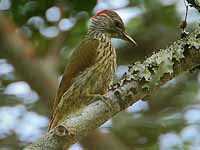
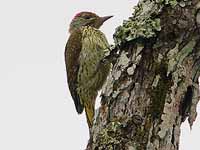
Woodpecker , Nubian Campethera nubica
Description: The nubian woodpecker has olive-brown upperparts with cream speckling. The male has a red crown, nape, and malar stripe. The female has a black crown speckled with white, red nape, and a white malar stripe with black speckles. They have greenish-brown wings with white barring and a greenish-yellow tail with brown barring. The throat is cream and the underparts white with black spots. It is 21 cm long.
Range: East Africa.
Habitat: Savannah woodland, especially with Acacia and Euphorbia, bushy areas and scrub.
Diet: Ants, termites; also beetles, spiders. Feeds mainly in trees but also on the ground.
Conservation status: Least Concern.
Image by: 1, 2) Dick Daniels - Masai Mara, Kenya 3) Brad Schram - Samburu National Reserve 4) Wifflepeg - Kenya Range: East Africa.
Habitat: Savannah woodland, especially with Acacia and Euphorbia, bushy areas and scrub.
Diet: Ants, termites; also beetles, spiders. Feeds mainly in trees but also on the ground.
Conservation status: Least Concern.
1, 2) Female 3, 4) Male

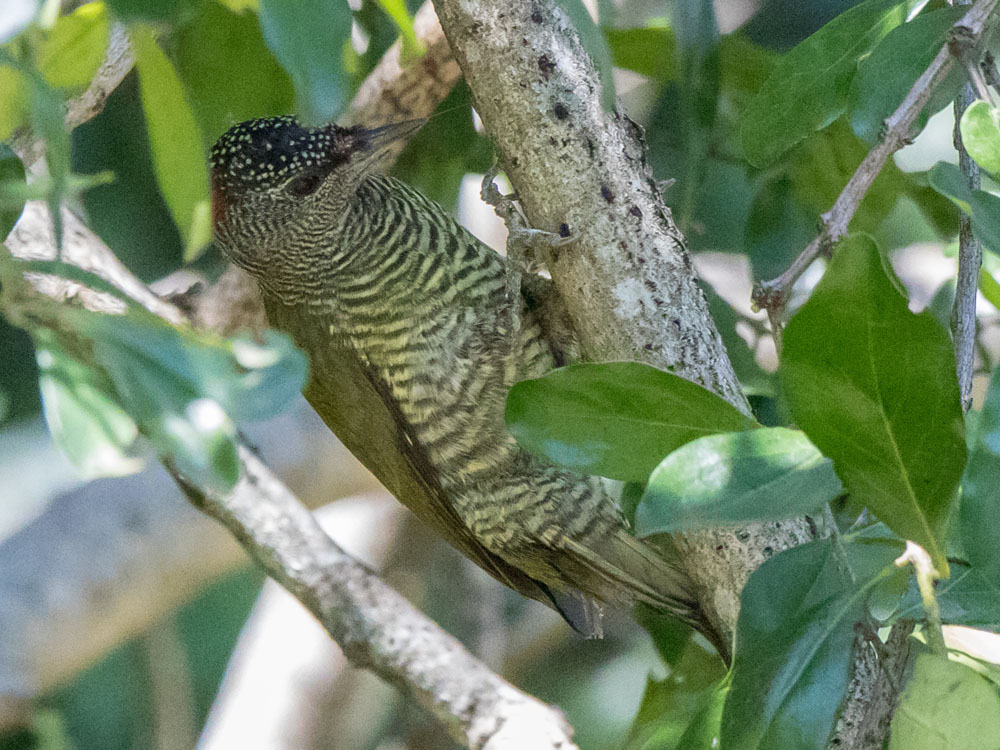
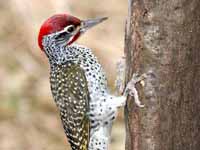
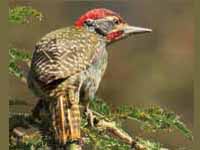
Woodpecker,_Tullberg's Campethera tullbergi
Description: The Tullberg's woodpecker has green upperparts. The male has a red crown while the has a black crown with white spots. They have a red nape and the rest of the head is whitish with small black spots It pale underparts with brown barring. It is a bout 19 cm long and 45 to 65 grams.
Range: Western Cameroon, adjacent Nigeria and Bioko island.
Habitat: Forests, forest edges; also isolated dead trees.
Diet: Mainly ants; also caterpillars. Forages in trees.
Conservation status: Least Concern.
Image by: 1) Nik Borrow - Cameroon 2) Peter_StewardRange: Western Cameroon, adjacent Nigeria and Bioko island.
Habitat: Forests, forest edges; also isolated dead trees.
Diet: Mainly ants; also caterpillars. Forages in trees.
Conservation status: Least Concern.
1, 2) Female
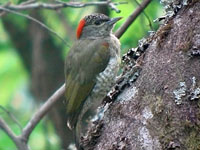

Genus Chloropicus also Dendropicos Found : Africa
Some references spread these species over two genera: Chloropicus and Dendropicos. They are treated here as belonging to just Chloropicus.
For many of these species, the male has red on most of its crown and nape while the female has mostly black on those locations. They are small to medium size woodpeckers varying in length from 12 to 25 cm. All excavate nest hole in trees. The entire nest tree may be dead, or merely the section where the cavity is located. They mainly eat insects, especially ant, termites, insect larvae, and caterpillars. Almost all foraging is done in trees, either by hammering with their bill or gleaning from surfaces. Of the 15 species in this genus, all but one are listed as Least Concern. The Stierling's woodpecker (Chloropicus stierlingi) has a status of Near Threatened.
Woodpecker, Abyssinian Chloropicus abyssinicus also Dendropicos abyssinicus Found: Africa
Description: The Abyssinian woodpecker has a golden yellow mantle. It has a bright red rump,red barred wings, and a red tail. The underparts are pale; there is a brown eye-line. The male has a red crown and red nape. It is 16 cm long and about 25 grams.
Range: Northeast Africa in Eritrea and Ethiopia.
Habitat: Forests and wooded savanna.
Diet: Unknown.
Conservation status: Least Concern.
Image by: 1) P_Khoo 2) Allan Drewitt 3) Nik_Borrow - EthiopiaRange: Northeast Africa in Eritrea and Ethiopia.
Habitat: Forests and wooded savanna.
Diet: Unknown.
Conservation status: Least Concern.
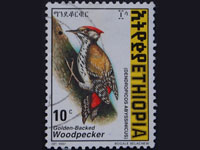
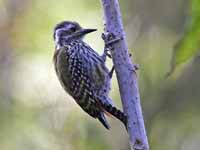
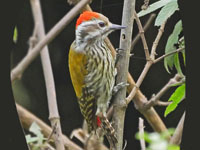
Woodpecker,_African_grey Chloropicus goertae also Dendropicos goertae
Description: The African grey woodpecker has unmarked green upperparts, a grey head, grey underparts, and a red rump. It has small red belly patch and a blackish tail. The male has a red crown and nape while the female has an entirely grey head. It is 20 cm long and 40 to 50 grams. The similar eastern grey woodpecker, which used to conspecific with the African grey woodpecker, does not. have red on its belly.
Range: Equatorial Africa.
Habitat: Woodlands and other areas such as savanna as long as there are some trees.
Diet: Insects, ants, beetle larvae. Forates mainly on trees; also on the ground.
Conservation status: Least Concern.
Image by: 1) Frans_Vandewalle - Gambia 2) JV Verde - Gambia 3, 4) Thom_Hasi - Senegal Range: Equatorial Africa.
Habitat: Woodlands and other areas such as savanna as long as there are some trees.
Diet: Insects, ants, beetle larvae. Forates mainly on trees; also on the ground.
Conservation status: Least Concern.
1, 2) Female 3, 4) Male
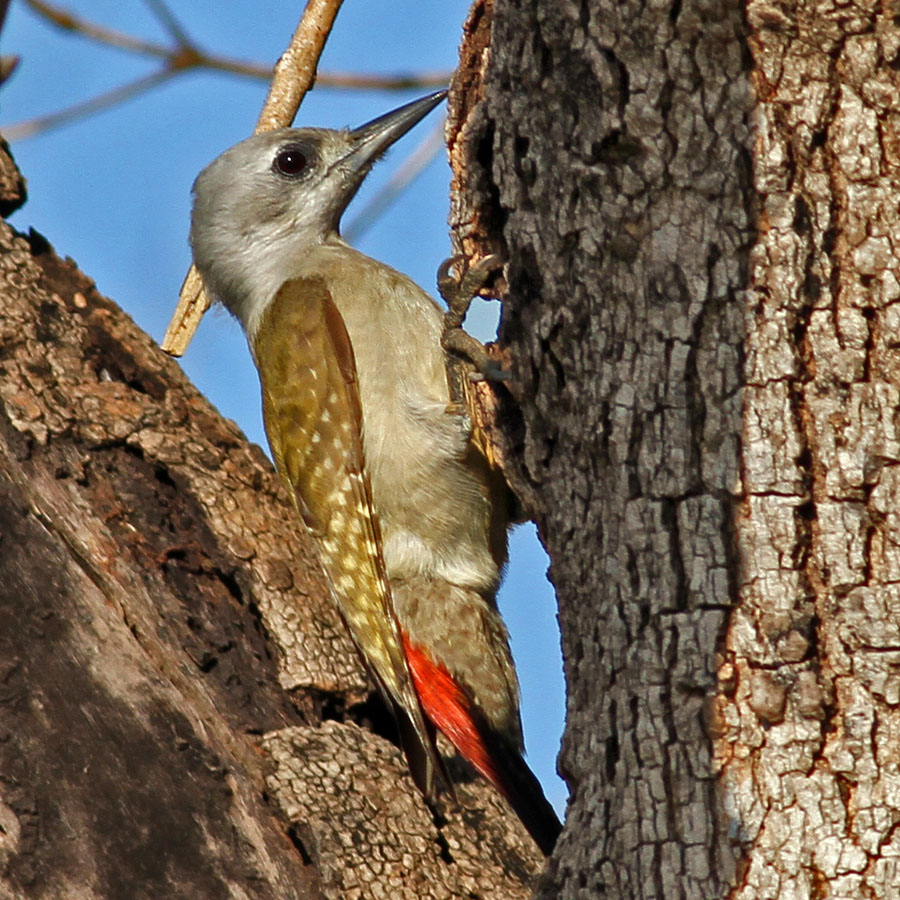

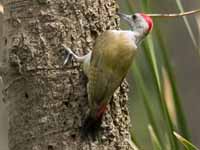
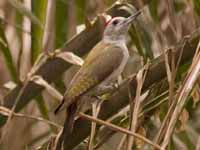
Woodpecker,_Bearded Chloropicus namaquus
Description: The bearded woodpecker has mainly yellowish-brown upperparts with narrow white barring and some black on top of the mantle. It has a brown tail barred white with yellowish shafts, grey underparts with narrow white barring, greyish-black bill, grey legs, red eyes, a white face with broad black eye-line, black crown, and a black throat. The male has a red hind-crown. The bearded woodpecker is 25 cm long and about 75 gtams which makes it one of the largest African woodpeckers.
Range: Southeastern Africa.
Habitat: Woodlands with large trees, forest edges, brushland.
Diet: Ants, termites, beetles, insect larvae. It forages in trees and on the ground.
Conservation status: Least Concern.
Image by: 1)) Bernard_Dupont - South Africa 2) Paul Seligman 3, 4) Nik_Borrow - TanzaniaRange: Southeastern Africa.
Habitat: Woodlands with large trees, forest edges, brushland.
Diet: Ants, termites, beetles, insect larvae. It forages in trees and on the ground.
Conservation status: Least Concern.
1. 2) Female 3, 4) Male
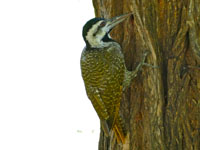
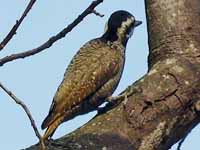
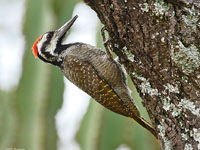
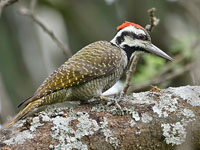
Woodpecker,_Brown-backed Chloropicus obsoletus also Dendropicos obsoletus
Description: The brown-backed woodpecker has brown upperparts with white barring except for the upper-back which is plain brown. The head has a brown crown, white face with a brown eye-line and brown malar stripe. The underparts are pale with faint stripes. The male has a red hind-crown and nape; the female does not. It is a small woodpecker with a length of 13 to 16 cm and a weight of about 20 grams.
Range: Central Africa.
Habitat: Open, dry areas, scrubland, the edges of woodland.
Diet: Insects and larvae. Foraging is restricted to trees.
Conservation status: Least Concern.
Image by: 1) Carol Foil - Kenya 2, 3, 4) Nik_Borrow - Ghana, Ghana, TanzaniaRange: Central Africa.
Habitat: Open, dry areas, scrubland, the edges of woodland.
Diet: Insects and larvae. Foraging is restricted to trees.
Conservation status: Least Concern.
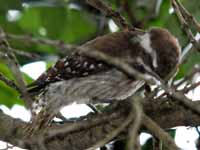
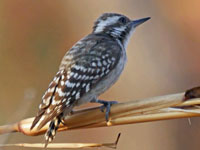


Woodpecker,_Cardinal Chloropicus fuscescens also Dendropicos fuscescens
Description: The cardinal woodpecker has a white spotted olive back and white underparts streaked with black. The face and throat are white with a black malar stripe. It has a brown fore-crown and a tawny rump. The male has a red hind-crown and nape; the female has a dark hind-crown and black nape. The cardinal woodpecker is about 15 cm long.
Range: Sub-Saharan Africa.
Habitat: Dense forest to thorn bush.
Diet: Insects, larvae which are found mainly in trees.
Conservation status: Least Concern.
Image by: 1, 2) Derek Keats 3) Hans Hillewaert -
Zambia
4) Ian White - South Africa Range: Sub-Saharan Africa.
Habitat: Dense forest to thorn bush.
Diet: Insects, larvae which are found mainly in trees.
Conservation status: Least Concern.
1, 2) Female 3, 4) Male
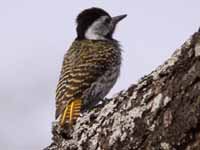
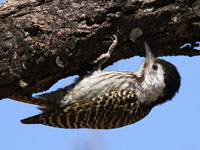
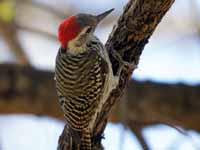
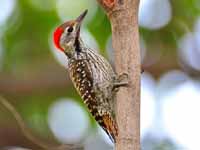
Woodpecker,_Eastern_grey Chloropicus spodocephalus also Dendropicos spodocephalus
Description: The eastern grey woodpecker, also known as mountain grey woodpecker, has yellowish-green upperparts, with brown wings and tail. The rump is red. It has a pale grey head. The male has a red crown and nape while for the female they are grey. They have pale grey underparts with a red patch on the lower-belly. It is 20 cm long. The similar African grey woodpecker, which used to be conspecific with the eastern grey woodpecker, does not have red on its belly.
Range: Eastern Africa.
Habitat: Forest, forest edges, montane forests to over 3000 meters.
Diet: Insects, larvae, centipedes. Forages in trees, on the ground, and can even take insects on the wing.
Conservation status: Least Concern.
Image by: 1) Lip_Kee - Ethiopia 2) Nik_Borrow - Ethiopia 3, 4) Sergey_Yeliseev - EthiopiaRange: Eastern Africa.
Habitat: Forest, forest edges, montane forests to over 3000 meters.
Diet: Insects, larvae, centipedes. Forages in trees, on the ground, and can even take insects on the wing.
Conservation status: Least Concern.
1, 2) Female 3, 4) Male
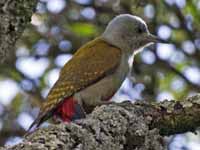

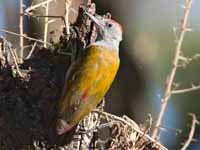
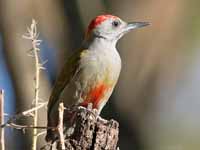
Woodpecker,_Elliot's Chloropicus elliotii also Dendropicos elliotii
Description: The Elliot's woodpecker has plain green upperparts with a brown on bronze tinge The wings are brown as is the upper-tail. It has a buff face with a black fore-crow. The underparts are whitish or yellowish with olive streaks and olive barring on the flanks. The male has a red rear-crown and nape. These are black on the female.
Range: West central Africa.
Habitat: Mainly a lowland bird, but also up to 2000 meters.
Diet: Insects, especially beetle larvae. It forages on trees.
Conservation status: Least Concern.
Image by: 1) Nik_Borrow - CameroonRange: West central Africa.
Habitat: Mainly a lowland bird, but also up to 2000 meters.
Diet: Insects, especially beetle larvae. It forages on trees.
Conservation status: Least Concern.
1) Male
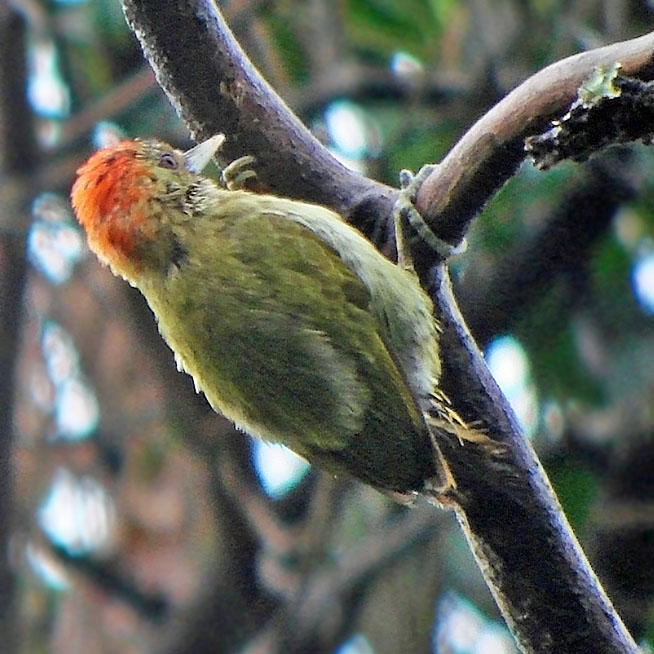
Woodpecker,_Fire-bellied Chloropicus pyrrhogaster
Description: The fire-bellied woodpecker has olive or bronze upperparts with slight barring, brown wings, blackish upper-tail, a red rump, and a white head with a broad eye-line extending to breast. It has a white throat, cream breast with chevrons on the flanks, and a scarlet central belly. The male has red crown and nape while the female has a black crown and nape. The fire-bellied woodpecker is about 24 cm long and 65 to 75 grams.
Range: Tropical west Africa.
Habitat: Clearing and edges of primary rainforest located in lowlands and foothills.
Diet: Insects, especially beetle larvae. It forages on trees.
Conservation status: Least Concern.
Image by 1, 2, 3) Nik_Borrow - Ghana Range: Tropical west Africa.
Habitat: Clearing and edges of primary rainforest located in lowlands and foothills.
Diet: Insects, especially beetle larvae. It forages on trees.
Conservation status: Least Concern.
1) Pair 2) Female 3) Male
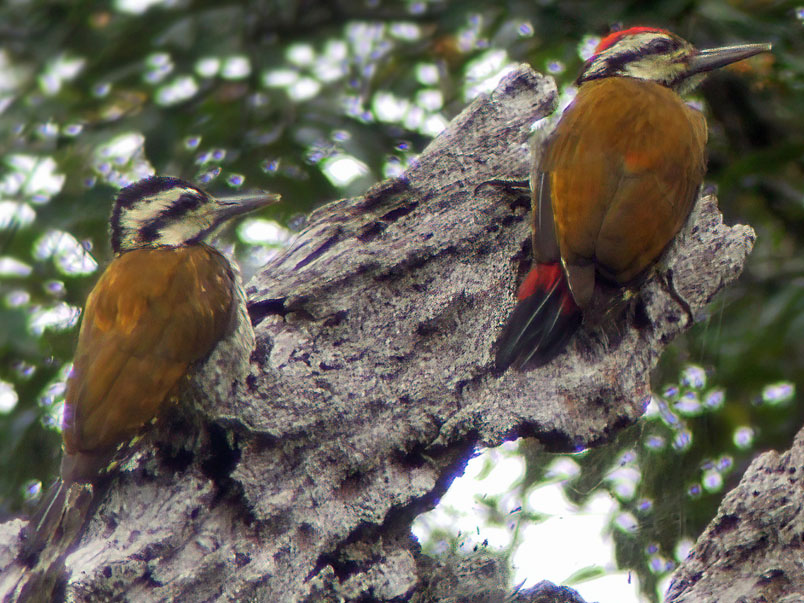

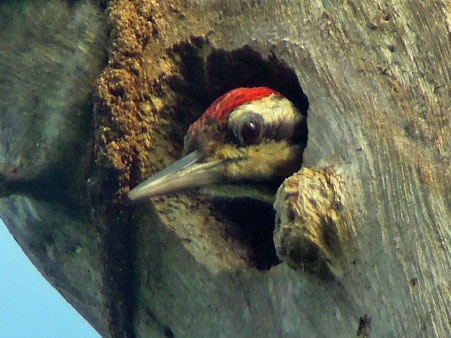
Woodpecker,_Gabon Chloropicus gabonensis also Dendropicos gabonensis
Description: The Gabon woodpecker has plain green upperparts and a darker plain tail. It has yellowish underparts with black spots and a brownish fore-crown. The male has a red hind-crown and nape. It is 17 cm long and weighs 25 to 30 grams.
Range: Western central Africa.
Habitat: Forest edge, tall secondary growth, farmland if trees are around. Avoids dense forest and savannas.
Diet: Insects and larvae, especially beetle larvae. It does not forage on the ground.
Conservation status: Least Concern.
Image by: 1) Nik_Borrow - Gabon 2) John Gerrard KeulemansRange: Western central Africa.
Habitat: Forest edge, tall secondary growth, farmland if trees are around. Avoids dense forest and savannas.
Diet: Insects and larvae, especially beetle larvae. It does not forage on the ground.
Conservation status: Least Concern.
1) Female 2) Male
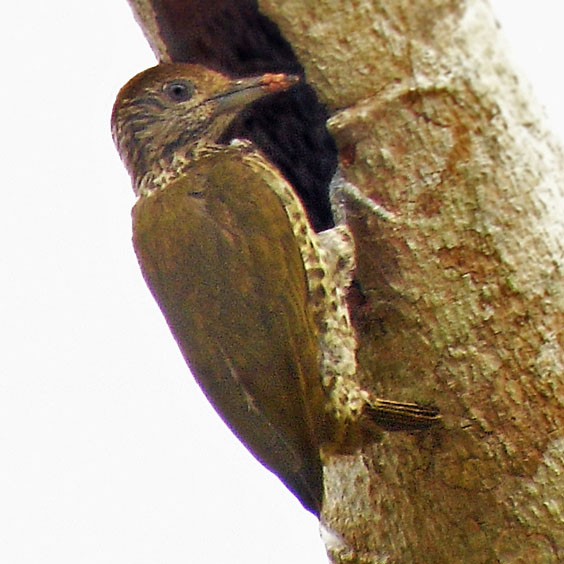
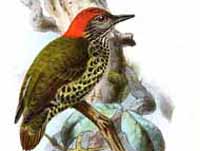
Woodpecker,_Golden-crowned Chloropicus xantholophus
Description: The golden-crowned woodpecker, also known as the yellow-crested woodpecker, has dull brownish-olive upperparts which are sometimes slightly barred. A black eye-line extends to the nape. It has a whitish face and throat. The underparts are brown with white spotting on the breast and white barring on the lower belly. The male has a small golden patch with black flecking on the crown. The golden-crowned woodpecker is 22 to 25 cm in length and 50 to 75 grams in weight.
Range: Central Africa.
Habitat: Primary or secondary rainforest, as well as drier forests, forest edges, and plantations of cocoa or coffee where there are some remaining large trees.
Diet: Insects, especially beetle larvae. It does not forage on the ground.
Conservation status: Least Concern.
Image by: 1) Francesco_Veronesi - Kenya 2) Peter_Steward - UgandaRange: Central Africa.
Habitat: Primary or secondary rainforest, as well as drier forests, forest edges, and plantations of cocoa or coffee where there are some remaining large trees.
Diet: Insects, especially beetle larvae. It does not forage on the ground.
Conservation status: Least Concern.
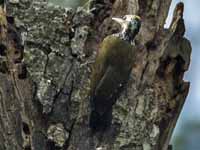
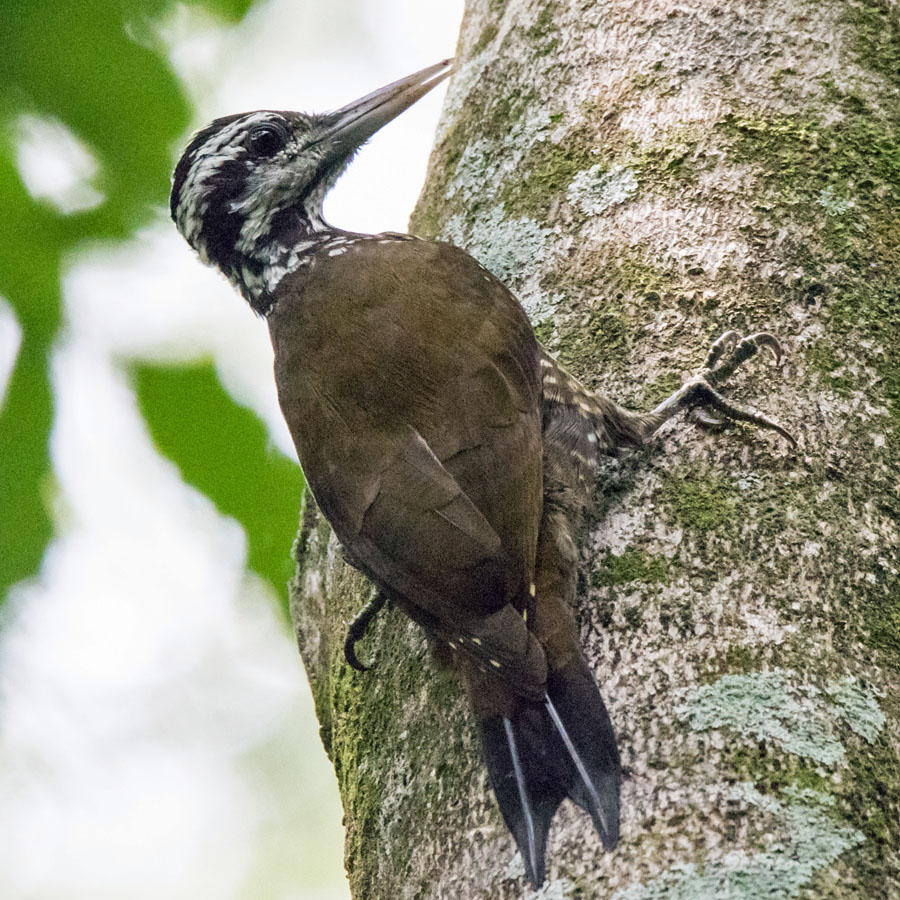
Woodpecker,_Little_grey Chloropicus elachus also Dendropicos elachus
Description: The little grey woodpecker has greyish-brown upperparts with white barring, a red rump, and a light brown head. Only the male has a red hind-crown and nape. The little grey woodpecker is little at 12 to 14 cm long and a weight of about 20 grams.
Range: Central Africa.
Habitat: Lightly wooded areas in relatively dry areas.
Diet: Insects, larvae.
Conservation status: Least Concern.
Image by: 1) Artwork from Univ. of AmsterdamRange: Central Africa.
Habitat: Lightly wooded areas in relatively dry areas.
Diet: Insects, larvae.
Conservation status: Least Concern.
1) Male
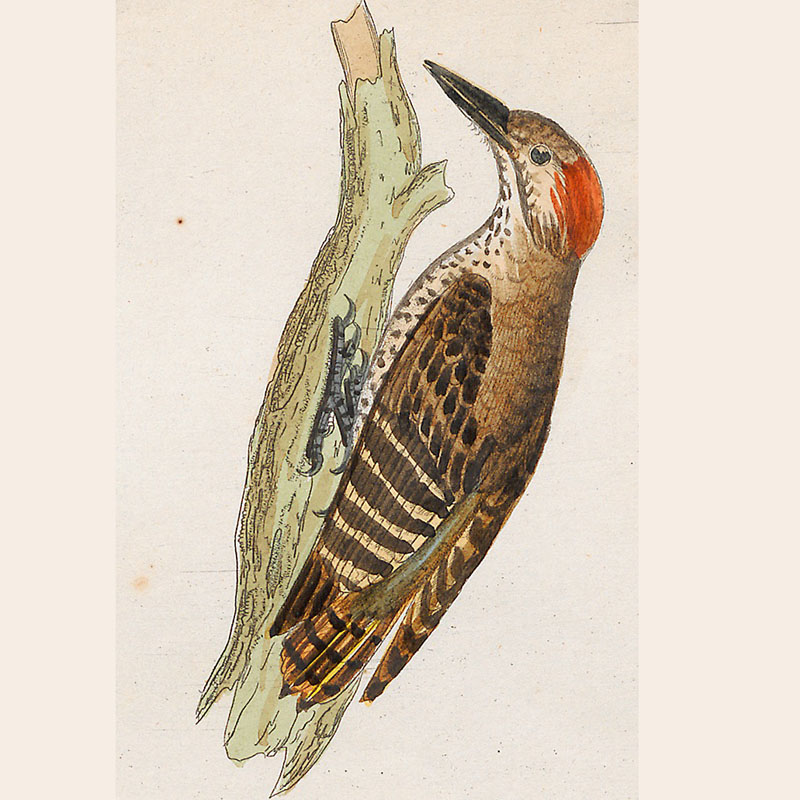
Woodpecker,_Melancholy Chloropicus lugubris also Dendropicos lugubris
Description: The melancholy woodpecker has bronzy-green upperparts, an olive-brown fore-crown, red (male) or black (female) rear-crown and nape, a white face, dusky ear-coverts, and white supercilium. The underparts are greenish-yellow with broad brown streaks. The melancholy woodpecker is about 17 cm long.
Range: Central Africa.
Habitat: Open forest, forest edges, clearings, secondary forest and woodlands, up to 1,200 m.
Diet: Insects. Forages in trees, mostly in the canopy.
Conservation status: Least Concern.
Image by: 1, 3) Nik_Borrow - Ghana 2) Francesco Veronesi - Ghana Range: Central Africa.
Habitat: Open forest, forest edges, clearings, secondary forest and woodlands, up to 1,200 m.
Diet: Insects. Forages in trees, mostly in the canopy.
Conservation status: Least Concern.
1) Female 2, 3) Male
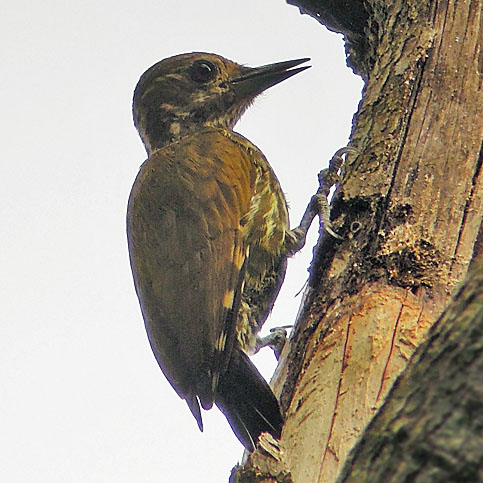
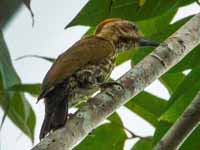
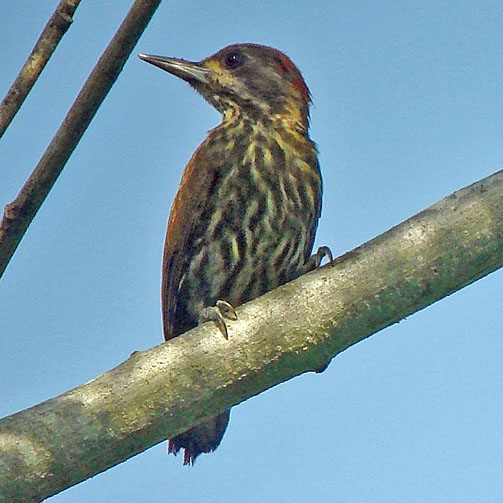
Woodpecker,_Olive Chloropicus griseocephalus also Dendropicos griseocephalus
Description: The olive woodpecker has olive-green upperparts with an orange tinged mantle. The head and neck are grey, except the male has red rear-crown and nape. It has grey underparts with a golden tinged breast. It has no barring or stripes. The olive woodpecker is about 20 cm long and 35 to 50 grams.
Range: Southern Africa.
Habitat: Wooded and forested habitats from 450–3,700 m.
Diet: Ants, beetles and their larvae; also other insects. Forages in trees.
Conservation status: Least Concern.
Image by: 1) Aviceda - Uganda 2) Nigel_Voaden - DR Congo 3) Francesco_Veronesi - South AfricaRange: Southern Africa.
Habitat: Wooded and forested habitats from 450–3,700 m.
Diet: Ants, beetles and their larvae; also other insects. Forages in trees.
Conservation status: Least Concern.
1) Female 2, 3) Male
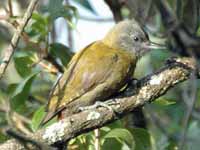

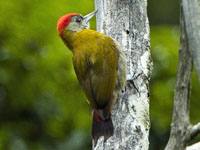
Woodpecker,_Speckle-breasted Chloropicus poecilolaemus also Dendropicos poecilolaemus
Description: The speckle-breasted woodpecker has yellow-green upperparts with barring on wing-coverts. The male has a dark brown fore-crown, red rear-crown and red nape while the female has a black crown and nape. They have a grey face with a thin black malar stripe. The pale grey neck sides and throat have darker dotted-streaks. The underparts are pale grey with some faint dots. The speckle-breasted woodpecker is about 15 cm long and 25 to 30 grams.
Range: Sub-Saharan Africa.
Habitat: Forest edges and clearings, treed savannas, and other areas with some trees.
Diet: Ants, caterpillars, beetles, larvae. Forages on trees.
Conservation status: Least Concern.
Image by: 1, 2, 3) Nik_Borrow - UgandaRange: Sub-Saharan Africa.
Habitat: Forest edges and clearings, treed savannas, and other areas with some trees.
Diet: Ants, caterpillars, beetles, larvae. Forages on trees.
Conservation status: Least Concern.
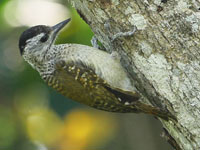
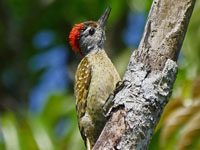
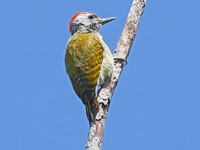
Woodpecker,_Stierling's Chloropicus stierlingi also Dendropicos stierlingi
Description: The Stierling's woodpecker has plain olive-brown upperparts and whitish underparts with brown markings. It has a white face, chin, and throat. There is a brown eye-line and a brown malar streak that extends to the breast. Its wings are brown above and white below, The eyes are reddish. The male has a red mid-crown and nape. The female has a brown crown with pale streaks and black nape. The Stierling's woodpecker is about 17 cm long and 25 to 30 grams.
Range: Malawi, Mozambique, Tanzania.
Habitat: Open miombo woodland, not dense forest. Found up to 1,500 meters.
Diet: Ants, caterpillars, centipedes, larvae. Forages on trees.
Conservation status: The Stierling's woodpecker is listed as Near Threatened because little is known about it.
Image by: 1, 2, 3, 4) Nik_Borrow - MalawiRange: Malawi, Mozambique, Tanzania.
Habitat: Open miombo woodland, not dense forest. Found up to 1,500 meters.
Diet: Ants, caterpillars, centipedes, larvae. Forages on trees.
Conservation status: The Stierling's woodpecker is listed as Near Threatened because little is known about it.
1, 2) Female 3, 4) Male
